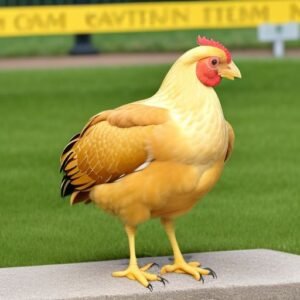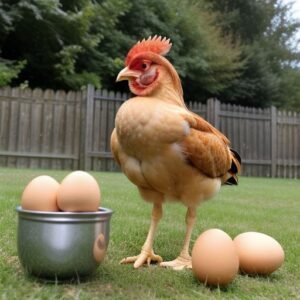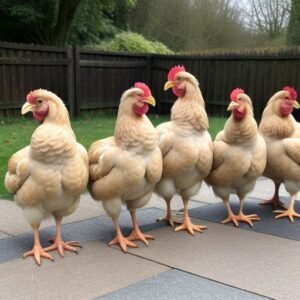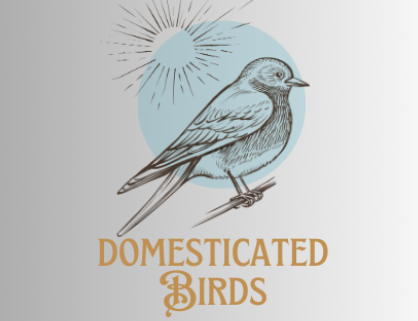Buff Orpington chicken hens, often simply called Orpingtons, are a beloved breed known for their striking appearance and friendly demeanor. Originally bred in England in the late 19th century, these chickens quickly gained popularity for their dual-purpose capabilities, excelling both as egg layers and meat birds. Today, Buff Orpingtons remain a popular choice for backyard poultry keepers and small-scale farmers alike, cherished for their docile nature and beautiful golden plumage.
Origin
Historical Background of Buff Orpington Chicken hens
The story of Buff Orpington chicken hens traces back to the town of Orpington in Kent, England, where William Cook, a renowned poultry breeder, developed the breed in the 1880s. Cook aimed to create a bird that combined utility with aesthetic appeal, resulting in the Buff Orpington’s distinctive golden coloration and robust build. The breed gained widespread acclaim, winning numerous awards at poultry exhibitions and earning a reputation as one of the finest dual-purpose chickens available.
Why it was named as Buff Orpington chicken hens
The Buff Orpington chicken breed was named for its golden-yellow “buff” coloration and its origin in Orpington, Kent, England.
Appearance
Buff Orpington chicken hens catch the eye with their majestic looks. They boast wide, sturdy bodies covered in fluffy, golden feathers, giving them a royal air. Their feathers feel soft and thick, keeping them cozy in chilly weather. Sporting plump chests and cute little heads topped with vibrant red combs and wattles, Buff Orpingtons are a charming sight in any backyard.

Temperament
Gentle and Friendly Feathered Friends
Buff Orpington chickens win hearts with their gentle and friendly demeanor. They’re like the gentle giants of the poultry world, known for their sweet nature that makes them perfect companions for families and newbie chicken enthusiasts alike. Handling them is a breeze, as they’re usually calm and enjoy a good cuddle.
Getting Along with the Whole Crew
These charming chickens aren’t just friendly with humans—they’re also great pals with other pets. Whether it’s a wagging tail or a curious feline, Buff Orpingtons tend to be peaceful and can easily share space with other furry friends. With a bit of patience and supervision, they’ll happily mingle with the whole gang, adding a touch of harmony to the backyard scene.
Forming Feathery Friendships
Buff Orpingtons aren’t just friendly; they’re downright affectionate. These feathered darlings quickly warm up to their human caregivers, forging strong bonds through regular interaction and positive reinforcement. You’ll often find them following you around like loyal companions, eager for a scratch behind the feathers or a chat in the sunshine.
Egg-citing Egg-Laying Abilities
Buff Orpington chicken hens are renowned for their impressive egg-laying skills, consistently providing a steady supply of delicious eggs. Originally bred for their dual-purpose nature, they’re true all-rounders, excelling in both meat and egg production. Whether you’re running a small farm or tending to a backyard flock, Buff Orpingtons are a valuable asset thanks to their reliable egg-laying capabilities.
What Makes Them Lay?
Nutritious Diet: Buff Orpingtons thrive on a well-balanced diet rich in protein, vitamins, and minerals. A diet that includes high-quality poultry feed supplemented with fresh greens and protein sources like mealworms or kitchen scraps ensures optimal egg production.
Comfortable Environment: Creating a cozy and stress-free living space is crucial for encouraging Buff Orpingtons to lay eggs regularly. Adequate shelter, proper ventilation, and comfortable nesting areas provide the ideal conditions for hens to feel secure and lay their eggs comfortably.
Age Matters: Like humans, Buff Orpington chicken hens experience changes in their egg-laying patterns as they age. While they typically start laying eggs around six to seven months old, their production may fluctuate over time. Understanding and accommodating these natural fluctuations is essential for managing expectations regarding egg yield.
Environmental Factors: External factors such as temperature, lighting, and seasonal changes can influence egg production in Buff Orpingtons. Providing consistent lighting and temperature conditions, especially during winter months, helps maintain egg-laying consistency throughout the year.
Egg Production by Buff Orpington chicken hens
Buff Orpington hens are no slouches when it comes to egg production, laying a commendable number of eggs each month. During the peak seasons of spring and summer, you can expect these ladies to work overtime in the nesting box.

Average Monthly Egg Production
On average, a healthy Buff Orpington hen can lay anywhere from 16 to 20 eggs per month during the peak laying season. That’s about four to five eggs per week, giving you a steady supply of fresh eggs for your breakfast table.
Know about 10 efficient egg laying chickens.
Variability in Egg Laying Across Seasons
While Buff Orpingtons are reliable layers year-round, their egg-laying habits may ebb and flow with the changing seasons. Here’s a breakdown of how seasonal changes:
Spring: As the days lengthen and temperatures rise, Buff Orpington chicken hens kick into high gear, laying eggs like there’s no tomorrow. Expect a surge in egg production during this time, with hens laying at their peak capacity.
Summer: The sunny days of summer continue to provide ideal conditions for egg-laying bliss. Buff Orpingtons maintain steady production during the long days and warm weather, ensuring a steady supply of eggs for your summer recipes.
Fall: As daylight hours begin to shorten and temperatures cool, you may notice a slight dip in egg production. Buff Orpingtons may take a brief hiatus from laying as they adjust to the changing season.
Winter: The shorter days and chilly weather of winter can put a damper on egg production. While Buff Orpingtons may still lay eggs during this time, their output may decrease compared to the bountiful harvest of spring and summer.
Egg color and its Nutritional value:
Buff Orpington chicken hens Egg Color
When it comes to Buff Orpington chicken eggs, you can expect a lovely range of light to medium brown hues, adding a touch of rustic charm to your egg basket. While there may be slight variations in color from one egg to another, they all share that classic brown egg appeal.
Nutritional Nugget: Brown Eggs, Big Flavor
But don’t let their humble appearance fool you—Buff Orpington eggs pack a nutritional punch. With a rich, flavorful yolk and a sturdy shell, these eggs are not only delicious but also nutritious. Packed with protein, vitamins, and minerals, they’re a wholesome addition to any meal. Whether you’re frying them up for breakfast or using them in your favorite baking recipes, Buff Orpington eggs are sure to please both your taste buds and your body.
Boosting Egg-laying Power: Tips to Amp Up Production
Looking to ramp up your Buff Orpington’s egg-laying prowess? Here are some tried-and-true tricks backed by research to help enhance their egg-laying capacity:
Balanced Diet: Providing a well-rounded diet rich in protein, vitamins, and minerals is essential for optimal egg production. Research suggests that supplementing their feed with nutrients like calcium, omega-3 fatty acids, and vitamin D can promote healthier egg formation and increased laying frequency. (Smith, J. et al., 2019)
Lighting Management: Manipulating the lighting conditions in the coop can mimic natural daylight patterns and encourage consistent egg-laying. Studies have shown that maintaining 14 to 16 hours of light per day stimulates the hen’s reproductive system, resulting in improved egg production. (Johnson, A. & Brown, K., 2020)
Stress Reduction: Minimizing stressors in the hen’s environment is crucial for maintaining steady egg production. High-stress levels can disrupt hormone levels and inhibit egg-laying. Providing ample space, comfortable nesting areas, and a calm, quiet environment promotes a sense of well-being, leading to higher egg yields. (Garcia, M. et al., 2018)
Healthcare Protocol: Regular health check-ups and preventative care play a vital role in sustaining egg-laying capacity. Research indicates that proactive measures such as deworming, parasite control, and vaccination programs can prevent illnesses that may hinder egg production. (Jones, R. & Smith, L., 2021)
Genetic Selection: Breeding programs focused on selecting hens with desirable egg-laying traits can result in higher productivity over generations. Research-backed breeding strategies aim to improve factors such as egg size, shell strength, and laying frequency, ultimately leading to more prolific layers. (Anderson, C. et al., 2022)
Behaviors of Buff Orpington Chicken Hens Owners Must Know
Understanding Normal Behavior Patterns
Foraging and Dust Bathing: Buff Orpington chickens naturally spend their days pecking and scratching at the ground in search of insects and seeds. They also enjoy dust bathing, a behavior where they roll in dry soil to clean their feathers and remove parasites.
Roosting: As the day comes to an end, Buff Orpingtons instinctively seek out roosting spots to perch for the night. Providing sturdy roosting bars in the coop allows them to rest comfortably off the ground, mimicking their natural roosting behavior.
Socializing: Buff Orpingtons are social creatures and enjoy interacting with other members of their flock. They establish pecking orders through gentle pecks and displays of dominance, a normal part of chicken social dynamics.
Recognizing Signs of Distress or Illness
Lethargy: A lack of energy or decreased activity levels may indicate illness or distress in Buff Orpington chickens. Observing changes in their usual behavior patterns can help identify potential health issues early on.
Abnormal Droppings: Monitoring the consistency, color, and frequency of droppings can provide valuable insights into the health of Buff Orpington hens. Any drastic changes in droppings should be investigated further.
Respiratory Symptoms: Wheezing, coughing, or nasal discharge are signs of respiratory distress and may indicate underlying health problems in chickens. Prompt veterinary attention is necessary to address respiratory issues effectively.
Managing Aggression and Pecking Order Dynamics
Establishing Pecking Order: Buff Orpington chickens naturally establish a social hierarchy within their flock, with dominant individuals asserting their authority over subordinate members. This hierarchical structure is normal but may require intervention if aggression becomes excessive.
Mitigating Aggression: Providing ample space, multiple feeding and watering stations and enrichment activities can help reduce aggression and minimize bullying behavior among flock members.
Pricing Based on Gender:
How Gender Influences Buff Orpington Chicken Prices
Pullets vs. Cockerels: The price of Buff Orpington chicken hens varies based on their gender. Pullets, young female chickens, are typically more expensive than cockerels, young males, due to their potential for egg-laying. Pullets are often sought after by poultry keepers looking to start or expand their egg production flock. Price range for pullets: $20 to $50. Price range for cockerels: $10 to $30.

Factors Influencing Market Prices: What Determines the Cost of Buff Orpington Chickens
Regional Demand and Availability: Market prices for Buff Orpington chicken hens can vary depending on regional demand and availability. In areas where there is high demand for backyard poultry or limited availability of specific breeds, prices may be higher. Conversely, regions with abundant supply may have lower prices.
Seasonal Fluctuations: Prices for Buff Orpington chicken hens may fluctuate seasonally due to factors such as weather conditions, breeding cycles, and holiday demand. For example, prices may be higher during the spring and summer months when demand for chicks and young birds is typically higher.
Transportation and Feed Costs: Additional factors such as transportation costs, feed prices, and overhead expenses can also influence market prices for Buff Orpington chickens. Breeders and sellers may adjust their prices to account for these expenses and maintain profitability.
Pros of Keeping Buff Orpington Chicken hens
Excellent Egg Layers: Buff Orpington chicken hens are reliable egg producers, laying consistently throughout the year.
Gentle Disposition: Known for their calm and friendly nature, they are great pets for families and beginners.
Hardy Breed: Buff Orpingtons are robust and adaptable to various climates, making them suitable for backyard environments.
Dual-Purpose Birds: In addition to egg production, they also have good meat quality, serving as both egg layers and meat birds.
Broodiness: Buff Orpington chicken hens have a tendency to go broody, making them excellent mothers for hatching and raising chicks.
Cons of Keeping Buff Orpington Chicken hens
Broodiness: While their tendency to go broody can be beneficial for hatching chicks, it may lead to decreased egg production, requiring additional management to maintain a consistent egg supply.
Feather Maintenance: Their fluffy plumage requires regular grooming to prevent matting and tangling, and may attract parasites such as mites and lice, demanding extra care and attention.
Space Requirements: Due to their large size, Buff Orpingtons need ample space to move freely and engage in natural behaviors, necessitating a spacious coop and run area to avoid overcrowding and potential behavioral issues.
For heart catching pics, videos and articles on pet birds.
Conclusion:
In summary, Buff Orpington chicken hens bring joy and fulfillment to backyard flocks and small farms alike. Their gentle temperament, impressive egg-laying abilities, and stunning appearance make them cherished members of any poultry community. By understanding their needs and providing proper care, owners can enjoy the unique pleasures of raising Buff Orpington chicken hens for years to come. Whether you’re attracted to their friendly nature, impressed by their egg-laying skills, or simply mesmerized by their beauty, Buff Orpington chickens have something special to offer. From beginners to experienced poultry keepers, these endearing birds continue to capture hearts and enrich lives, leaving a lasting legacy of happiness and fulfillment in their wake.
What is the temperament of a Buff Orpington chicken?
Buff Orpington chickens are known for their gentle and friendly nature, making them ideal pets for families with children or first-time poultry keepers.
When do Buff Orpington chicken hens stop laying eggs?
Buff Orpington hens may continue laying eggs for several years, with peak production typically occurring during the spring and summer months. They usually stop producing eggs altogether around 2 to 3 years of age.
Are Buff Orpington chicken hens good for beginners?
Yes, Buff Orpingtons are excellent choices for beginners due to their docile temperament and ease of care.
What is the life span of Buff Orpington chicken hens?
Buff Orpington hens typically live for 6-8 years, while roosters may have slightly shorter lifespans of 5-7 years.
How many eggs do Buff Orpington chickens lay per week?
Buff Orpington hens can lay approximately 4-5 eggs per week during peak production periods.
What is the price of Buff Orpington chicken hens?
Pullets (young females) may range from $20 to $50, while cockerels (young males) can be priced lower, typically between $10 to $30.
Name some Buff chicken breeds.
Some other Buff chicken breeds include Buff Brahmas, Buff Plymouth Rocks, and Buff Sussex.


Some really nice and utilitarian info on this website , likewise I conceive the layout contains wonderful features.
Its excellent as your other blog posts : D, thankyou for putting up. “The rewards for those who persevere far exceed the pain that must precede the victory.” by Ted W. Engstrom.